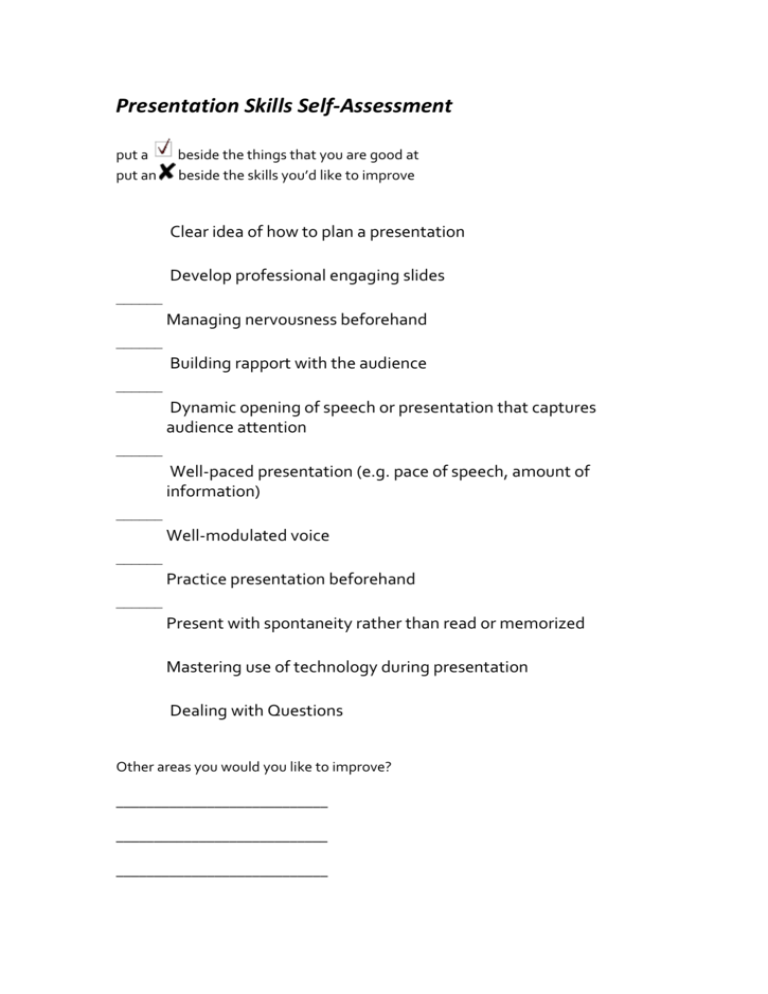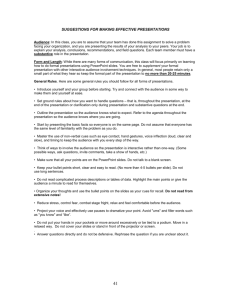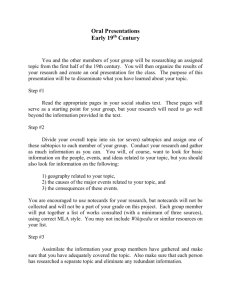Presentation Skills Self-Assessment
advertisement

Presentation Skills Self-Assessment put a put an beside the things that you are good at beside the skills you’d like to improve Clear idea of how to plan a presentation Develop professional engaging slides ______ Managing nervousness beforehand ______ Building rapport with the audience ______ Dynamic opening of speech or presentation that captures audience attention ______ Well-paced presentation (e.g. pace of speech, amount of information) ______ Well-modulated voice ______ Practice presentation beforehand ______ Present with spontaneity rather than read or memorized Mastering use of technology during presentation Dealing with Questions Other areas you would you like to improve? ____________________________ ____________________________ ____________________________ Presentation Interview Interview your partner and get answers to the following questions in 2 minutes. Take brief notes and then report back. 1. What is your experience of giving presentations? 2. What do you like about it? 3. What do you dislike about it? 4. Will you need to present in the future? Giving Presentations Overview: Presenting your research at a conference for the first time may be a daunting task. This short guide should help you to plan, prepare, practice and deliver your presentation. Resources Required: MS PowerPoint, Mac Keypoint Planning What? Why? Where? First of all, answer the following questions? Who is your audience? Why are they there? How long will it be? Where will it take place? Simplicity Simplicity is the key to a good presentation. Here are a few tips: Focus on the most important points Have one key message around which you base your presentation Write down 3 things that you want the audience to take away with them Develop an outline Don't open PowerPoint Work in a form (e.g. pen & paper) that allows you be creative Establish the key points that you will focus on Work out your key message Develop the logical flow of your presentation Structure Good presentations have an engaging beginning, a more detailed middle and a final summary ending. Intro: This includes a thesis statement or overview. Try to get the attention of the audience with an interesting fact, a question, something humorous or an eye-catching visual aid. The first few minutes are critical! Middle: This part of your talk covers the main points (remember the Kiss principle, “Keep It Simple Stupid”). This is where you develop your position. Try to link your ideas coherently so the presentation flows and makes sense. End: This is where you briefly sum up your talk by restating the main points and presenting your conclusions. Make sure to thank people and ask for comments/questions. More? Always check the conference guidelines for specific details re. time, resources available etc. Preparing Preparing your presentation is straightforward if you've planned your talk well and have a logical well-developed outline and structure. Nowadays, PowerPoint dominates presentations. Remember it is only a small element of your presentation. The following tips should help you in your preparation. 3 friends Prepare 3 documents for your presentation: 1) Your notes which no else sees 2) Handouts with more detailed information & references 3) Visual aids (usually PowerPoint) that support your talk and help engage the audience. PowerPoint Tips Keep text to a minimum - avoid full sentences, keep level of bullets to a minimum. Use colour to focus people on the most important details. Use your content. images to support Accessibility Prepare a presentation that welcomes everyone. Below are some guidelines: o o o o o o o o o Minimum font size of 18 (ideally 30) Easily read fonts (sans serif) like Arial, Helvetica, Tahoma. Limit the amount of onscreen information Avoid blocks of text Use ‘bold’ to highlight points rather than underlining Use both uppercase and lowercase letters (avoid ALL UPPERCASE) Keep backgrounds simple, avoid patterns Dark text on light background for bright rooms Light text on dark background for dark rooms. More? o o o Images for your Presentation: http://sxc.hu/ (free) www.istockphoto.com (commercial) PowerPoint Themes: http://www.presentationmagazine.com/free_powerpoint_template.h tm (free) http://www.presentationload.com (commercial) Practicing Most people never practice delivering their presentation. It is essential. It gives you a chance to correct things you don’t like and it gives you confidence. Preparation and practice are the best medicine for nerves: 1. Become familiar with the venue - practice there if possible. 2. Try imagining the room and giving the presentation in a successful way. 3. Anticipate what might go wrong and prepare ahead, i.e. a glass of water in case your mouth goes dry. 4. Take a deep breath, inhaling through the nose and exhaling through your mouth to relieve tension – no one can see you do it! 5. If you need to use a script, make sure that it’s written in casual spoken language. Even the best speakers often write down the wording of key phrases. 6. Work out what you are going to do with your body: are you going to stand behind the podium? If so, how can you ensure you connect with the audience? If you are going to stand in front of the audience, what are you going to do with your hands? 7. Have a bottle of water – it will help you pause naturally, stop your voice from going dry and it also helps to relax you. 8. Before your talk, build up your confidence and warm up your voice by asking questions in previous presentations or by talking to audience members as they come into the room. 9. Finally, make sure you have some time before your talk to relax and take your mind off your presentation. If you’ve prepared your material and practiced your presentation, you’ll be fine! Rehearse In a place as similar to the real venue that you can find Build up to your performance. Only practice doing it right. Cardinal sins If you are presenting a conference paper DO NOT READ IT – have a hard copy as a handout Do not turn your back on the audience Do not read from your slides More? Try to get a friend to listen to your practice and ask them for honest feedback More tips on practicing your speech: http://sixminutes.dlugan.com/speech-preparation-8-practice-presentation/ Presenting on the Day If you've followed the previous steps, then on the day you can focus on delivering your presentation in the most engaging way. If possible check out the room to ensure everything works and you have an idea of the layout. Try not to “read” your talk. Use cue cards to prompt your memory. Use a conversational tone. Make sure you are speaking loud enough to be heard. Try to be enthusiastic. Make sure to pause between points, indicating to the audience a change and helps to slow down your pace. Body Language Body language has a significant impact on an audience’s impression. maintain eye contact face the audience try smiling occasionally! Relaxation Techniques Breathing – Positive Thinking – Bottle of water Final Check Check room, time, equipment – get grounded Check sound levels Practice your timing Check that your presentation works Be enthusiastic and enjoy your presentation. If you don’t, no one else will. More? o more delivery tips see here: http://www.garrreynolds.com/Presentation/delivery.html Graphical Examples of bad and good powerpoint Box 3: Presentations vs. Journals Presentations Journal Papers Introduction 40% 5-10 % Ideas Ideas 1 per 5 mins. No limit Repetition Repetition desirable Undesirable Length Length - available time Depends on journal Visuals A lot of Visual material Only where relevant Grammar 1st and 2nd person 1st sometimes, 2nd never Tone Conversational Formal The Good and The Bad Powerpoint GENERAL GUIDELINES FOR PRESENTING Garr Reynolds 10 tips to presenting 1. Keep it simple 2. Limit bullets & text 3. Limit transitions and animations 4. Use high-quality graphics Avoid using PowerPoint Clip Art or other cartoonish line art. Again, if it is included in the software, your audience has seen it a million times before. 5. Have a visual theme but avoid Powerpoint templates 6. Use appropriate charts Always be asking yourself, "How much detail do I need?" Presenters are usually guilty of including too much data in their on-screen charts. 7. Use colour well Colour evokes feelings. Colour is emotional. The right colour can help persuade and motivate. Studies show that colour usage can increase interest and improve learning comprehension and retention. 8. Choose your fonts well Gill Sans as it is somewhere in between a serif and a sans-serif font and is professional yet friendly and "conversational." 9. Use Audio & Video 10. Spend time with the slide sorter For more detail on these points visit this website: http://www.garrreynolds.com/Presentation/index.html 10/20/30 Rule Guy Kawaski’s 10/20/30 Rule of Powerpoint states that a presentation: “should have ten slides, last no more than twenty minutes, and contain no font smaller than thirty points.” 10 20 30 Ten is the optimal number of slides in a PowerPoint presentation because a normal human being cannot comprehend more than ten concepts in a meeting “You should give your ten slides in twenty minutes. Sure, you have an hour time slot, but you’re using a Windows laptop, so it will take forty minutes to make it work with the projector. Even if setup goes perfectly, people will arrive late and have to leave early. In a perfect world, you give your pitch in twenty minutes, and you have forty minutes left for discussion.” The reason people use a small font is twofold: -> they don’t know their material well enough -> they think that more text is more convincing. Force yourself to use no font smaller than thirty points. It will make your presentations better because it requires you to find the most salient points and to know how to explain them well. PowerPoint Accessibility AHEAD guidelines 2008 http://www.ahead.ie Minimum font size of 18 (ideally 30) Try to use easily read fonts (sans serif) like Arial Limit the amount of onscreen information Avoid blocks of text Use ‘bold’ to highlight points rather than underlining Use bullet points rather than sentences Use pictures or simple diagrams to illustrate points Use double rather than single spacing Use both uppercase and lowercase letters (avoid ALL UPPERCASE) Use sufficient colours and brightness for better visibility Keep backgrounds simple, avoid patterns Have a theme: Maintain consistency of style and colour through presentation







